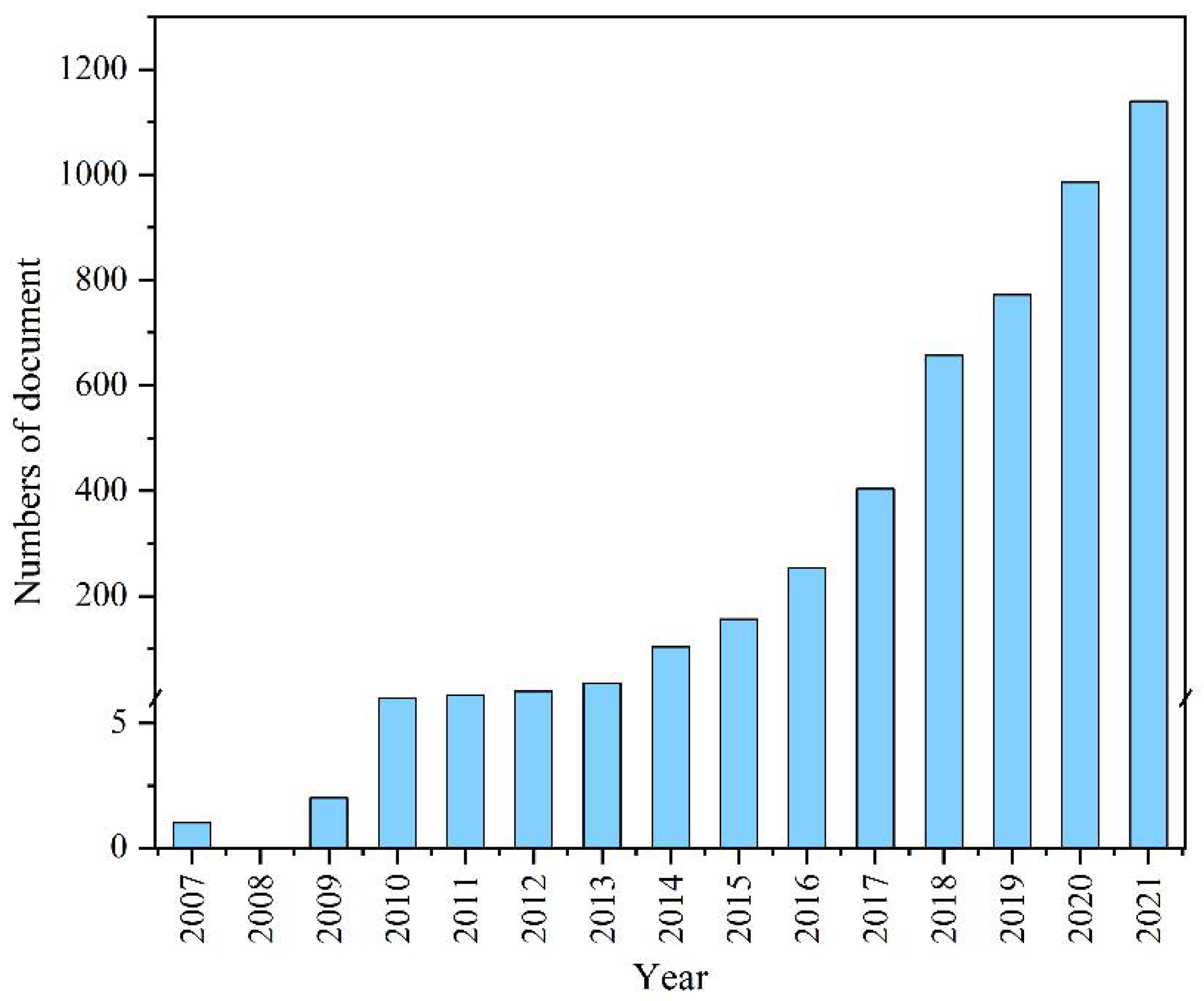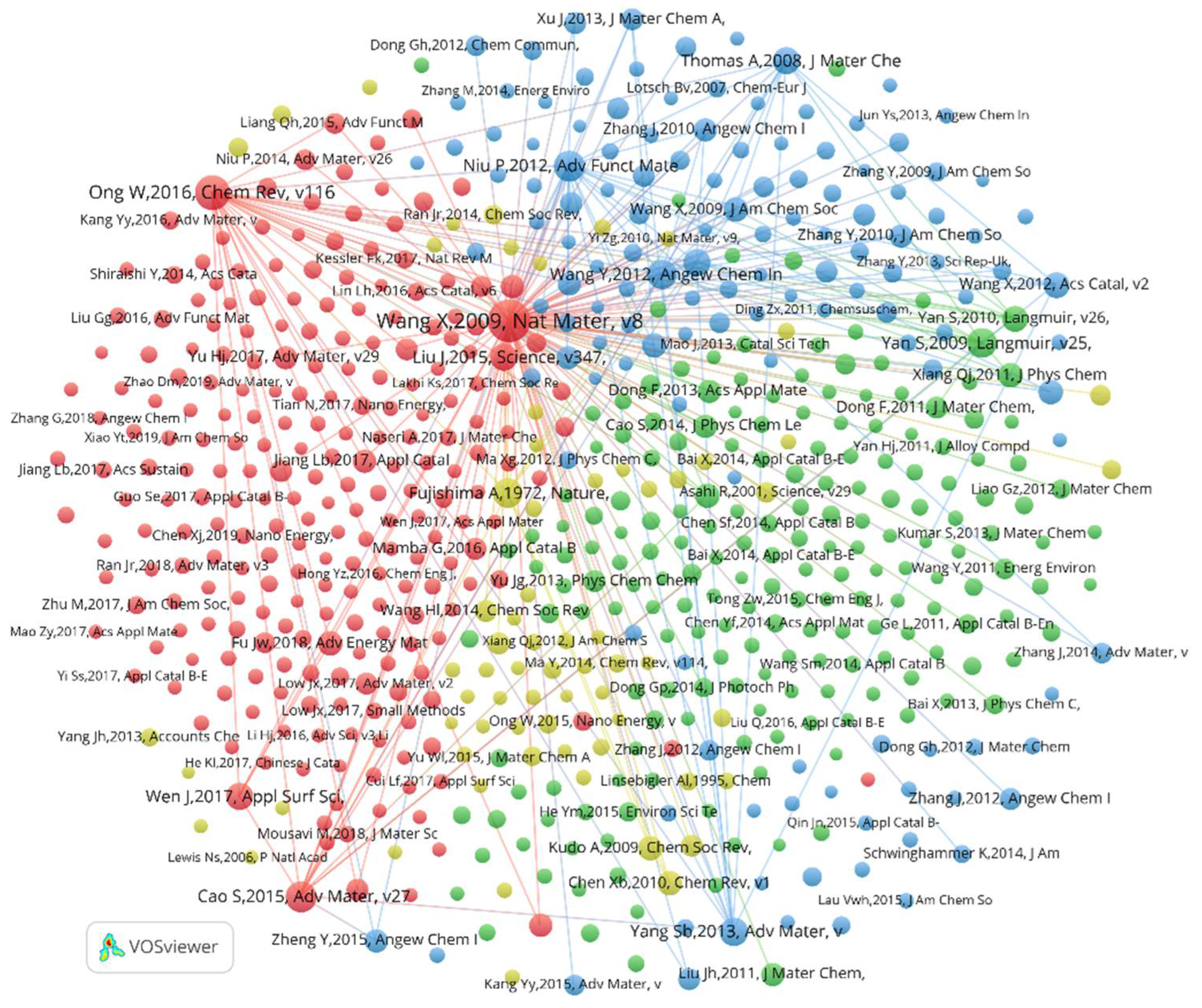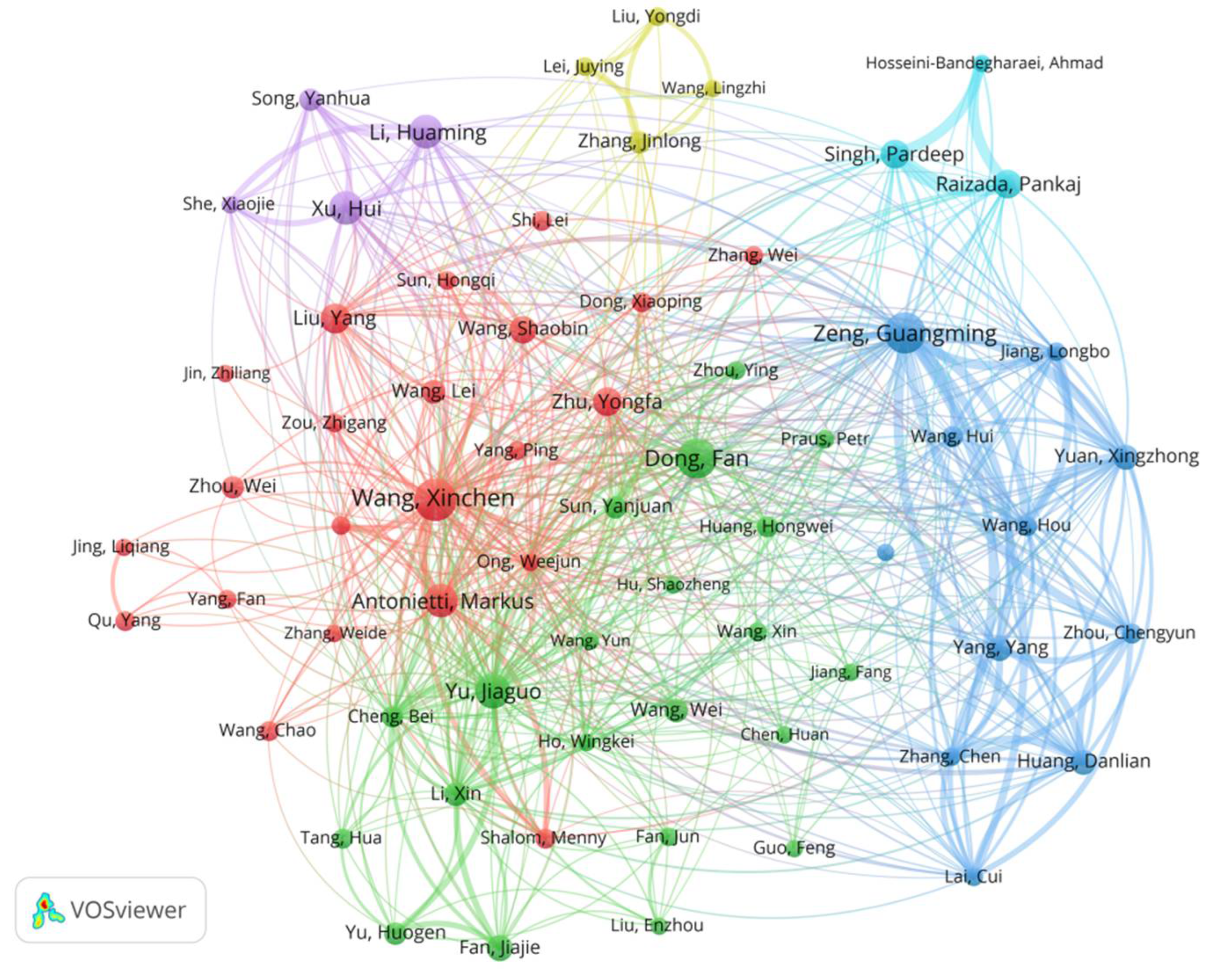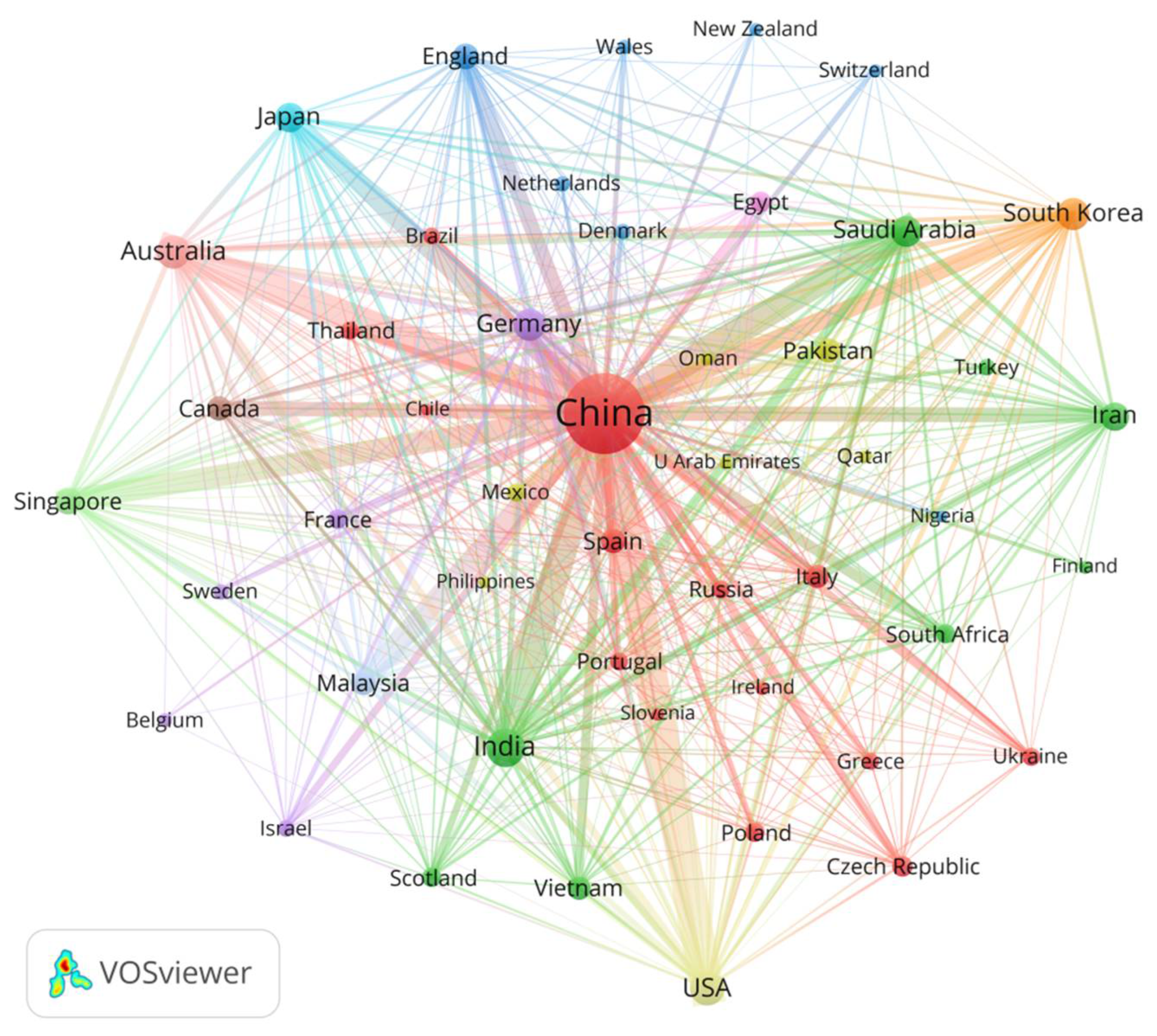Photocatalytic Applications of g-C3N4 Based on Bibliometric Analysis
Abstract
:1. Introduction
2. Results and Discussion
2.1. Analysis of the Number of Articles Issued over the Years
2.2. Co-Citation Analysis on Cited References
2.3. Collaborative Mapping Analysis
2.3.1. Author Collaboration Map
2.3.2. Journal Mapping Analysis
2.3.3. Most Influential Countries
2.4. Clustering and Co-Occurrence of Keywords
2.5. Co-Occurrence and Burst Mapping of Keywords
3. Materials and Methods
3.1. Data Source
3.2. Analysis Method
4. Conclusions and Future Prospects
Author Contributions
Funding
Data Availability Statement
Conflicts of Interest
References
- Hu, S.; Ma, L.; Xie, Y.; Li, F.; Fan, Z.; Wang, F.; Wang, Q.; Wang, Y.; Kang, X.; Wu, G. Hydrothermal synthesis of oxygen functionalized S-P codoped g-C3N4 nanorods with outstanding visible light activity under anoxic conditions. Dalton Trans. 2015, 44, 20889–20897. [Google Scholar] [CrossRef] [PubMed]
- Liu, X.; Ji, H.; Wang, J.; Xiao, J.; Yuan, H.; Xiao, D. Ozone treatment of graphitic carbon nitride with enhanced photocatalytic activity under visible light irradiation. J. Colloid Interface Sci. 2017, 505, 919–928. [Google Scholar] [CrossRef] [PubMed]
- Ismael, M. A review on graphitic carbon nitride (g-C3N4) based nanocomposites: Synthesis, categories, and their application in photocatalysis. J. Alloys Compd. 2020, 846, 156446. [Google Scholar] [CrossRef]
- Zhang, B.; Ma, J.; Chi, H.; Ding, A.; Xin, Y.; Ma, Y.; Liu, Q.; He, X. Novel VUV/g-C3N4 system with high adaptability to varied environmental conditions and outstanding degradation capacity for chlorophenols. J. Hazard. Mater. 2021, 419, 126473. [Google Scholar] [CrossRef] [PubMed]
- Habibi-Yangjeh, A.; Pirhashemi, M.; Pouran, S.R. Review on the criteria anticipated for the fabrication of highly efficient ZnO-based visible-light-driven photocatalysts. J. Ind. Eng. Chem. 2018, 62, 1–25. [Google Scholar]
- Tan, Y.; Shu, Z.; Zhou, J.; Li, T.; Wang, W.; Zhao, Z. One-step synthesis of nanostructured g-C3N4/TiO2 composite for highly enhanced visible-light photocatalytic H2 evolution. Appl. Catal. B Environ. Int. J. Devoted Catal. Sci. Its Appl. 2018, 230, 260–268. [Google Scholar] [CrossRef]
- Wang, J.; Yang, Z.; Gao, X.; Yao, W.; Wei, W.; Chen, X.; Zong, R.; Zhu, Y. Core-shell g-C3N4@ZnO composites as photoanodes with double synergistic effects for enhanced visible-light photoelectrocatalytic activities. Appl. Catal. B Environ. 2017, 217, 169–180. [Google Scholar] [CrossRef]
- He, W.; Liu, L.; Ma, T.; Han, H.; Zhu, J.; Liu, Y.; Fang, Z.; Yang, Z.; Guo, K. Controllable morphology CoFe2O4/g-C3N4 p-n heterojunction photocatalysts with built-in electric field enhance photocatalytic performance. Appl. Catal. B Environ. 2022, 306, 121107. [Google Scholar] [CrossRef]
- Liang, X.; Dong, F.; Tang, Z.; Wang, Q. The significant promotion of g-C3N4 on Pt/CNS catalyst for the electrocatalytic oxidation of methanol. Int. J. Hydrog. Energy 2021, 46, 39645–39657. [Google Scholar] [CrossRef]
- Xiong, T.; Cen, W.; Zhang, Y.; Dong, F. Bridging the g-C3N4 interlayers for enhanced photocatalysis. ACS Catal. 2016, 6, 2462–2472. [Google Scholar] [CrossRef]
- Tena, M.T. Combination of Au-Ag plasmonic nanoparticles of varied compositions with carbon nitride for enhanced photocatalytic degradation of ibuprofen under visible light. Materials 2021, 14, 3912. [Google Scholar]
- Wang, Y.; Yang, W.; Chen, X.; Wang, J.; Zhu, Y. Photocatalytic activity enhancement of core-shell structure g-C3N4@TiO2 via controlled ultrathin g-C3N4 layer. Appl. Catal. B Environ. 2017, 220, 337–347. [Google Scholar] [CrossRef]
- Chen, R.-R.; Ren, Q.-F.; Liu, Y.-X.; Ding, Y.; Zhu, H.T.; Xiong, C.-Y.; Jin, Z.; Oh, W.-C. Synthesis of g-C3N4/diatomite/MnO2 composites and their enhanced photo-catalytic activity driven by visible light. J. Korean Ceram. Soc. 2021, 58, 548–558. [Google Scholar] [CrossRef]
- Sun, Z.; Zhu, M.; Fujitsuka, M.; Wang, A.; Majima, T. Phase effect of NixPy hybridized with g-C3N4 for photocatalytic hydrogen generation. ACS Appl Mater Interfaces 2017, 9, 30583–30590. [Google Scholar] [CrossRef] [PubMed]
- Lv, H.; Huang, Y.; Koodali, R.T.; Liu, G.; Zeng, Y.; Meng, Q.; Yuan, M. Synthesis of sulfur-doped 2D graphitic carbon nitride nanosheets for efficient photocatalytic degradation of phenol and hydrogen evolution. ACS Appl. Mater. Interfaces 2020, 12, 12656–12667. [Google Scholar] [CrossRef] [PubMed]
- Fang, Y.; Li, X.; Wang, Y.; Giordano, C.; Wang, X. Gradient sulfur doping along polymeric carbon nitride films as visible light photoanodes for the enhanced water oxidation. Appl. Catal. B Environ. 2019, 268, 118398. [Google Scholar] [CrossRef]
- Cao, S.; Fan, B.; Feng, Y.; Chen, H.; Jiang, F.; Wang, X. Sulfur-doped g-C3N4 nanosheets with carbon vacancies: General synthesis and improved activity for simulated solar-light photocatalytic nitrogen fixation. Chem. Eng. J. 2018, 353, 147–156. [Google Scholar] [CrossRef]
- Chubenko, E.B.; Baglov, A.V.; Leonenya, M.S.; Yablonskii, G.P.; Borisenko, V.E. Structure of photoluminescence spectra of oxygen-doped graphitic carbon nitride. J. Appl. Spectrosc. 2020, 87, 9–14. [Google Scholar] [CrossRef]
- Wang, H.; Guan, Y.; Hu, S.; Pei, Y.; Ma, W.; Fan, Z. Hydrothermal synthesis of band gap-tunable oxygen-doped g-C3N4 with outstanding "Two-Channel" photocatalytic H2O2 production ability assisted by dissolution–precipitation process. Nano 2019, 14, 99–110. [Google Scholar] [CrossRef]
- Zhang, B.; Li, X.; Zhao, Y.; Song, H.; Wang, H. Facile synthesis of oxygen doped mesoporous graphitic carbon nitride with high photocatalytic degradation efficiency under simulated solar irradiation. Colloids Surf. A Physicochem. Eng. Asp. 2019, 580, 123736. [Google Scholar] [CrossRef]
- Zhu, Y.; Chen, Z.; Gao, Y.; Hu, C. General synthesis of carbon and oxygen dual-doped graphitic carbon nitride via copolymerization for non-photochemical oxidation of organic pollutant. J. Hazard. Mater. 2020, 394, 122578. [Google Scholar] [CrossRef] [PubMed]
- Qi, H.; Liu, Y.; Li, C.; Zou, X.; Huang, Y.; Wang, Y. Precursor-reforming protocol to synthesis of porous N-doped g-C3N4 for highly improved photocatalytic water treatments. Mater. Lett. 2020, 264, 127329. [Google Scholar] [CrossRef]
- Gao, B.; Wang, J.; Dou, M.; Huang, X.; Yu, X. Novel nitrogen-rich g-C3N4 with adjustable energy band by introducing triazole ring for Cefotaxime removal. Sep. Purif. Technol. 2020, 241, 116576. [Google Scholar] [CrossRef]
- Wu, M.; Gong, Y.; Nie, T.; Zhang, J.; Wang, R.; Wang, H.; He, B. Template-free synthesis of nanocage-like g-C3N4 with high surface area and nitrogen defects for enhanced photocatalytic H2 activity. J. Mater. Chem. A 2019, 7, 5324–5332. [Google Scholar] [CrossRef]
- Wang, X.; Maeda, K.; Thomas, A.; Takanabe, K.; Xin, G.; Carlsson, J.M.; Domen, K.; Antonietti, M. A metal-free polymeric photocatalyst for hydrogen production from water under visiblelight. Nat. Mater. 2009, 8, 76–80. [Google Scholar] [CrossRef] [PubMed]
- Ding, X.; Yang, Z. Knowledge mapping of platform research: A visual analysis using VOSviewer and CiteSpace. Electron. Commer. Res. 2020, 22, 787–809. [Google Scholar] [CrossRef]
- Ong, W.J.; Tan, L.L.; Ng, Y.H.; Yong, S.T.; Chai, S.P. Graphitic carbon nitride (g-C3N4)-based photocatalysts for artificial photosynthesis and environmental remediation: Are we a step closer to achieving sustainability? Chem. Rev. 2016, 116, 7159–7329. [Google Scholar] [CrossRef]
- Cao, S.; Low, J.; Yu, J.; Jaroniec, M. Polymeric photocatalysts based on graphitic carbon nitride. Adv. Mater. 2015, 27, 2150–2176. [Google Scholar] [CrossRef]
- Wen, J.; Xie, J.; Zhang, H.; Zhang, A.; Li, X. Constructing multifunctional metallic Ni interface layers in the g-C3N4 nanosheets/amorphous NiS heterojunctions for efficient photocatalytic H2 generation. ACS Appl. Mater. Interfaces 2017, 9, 14031–14042. [Google Scholar] [CrossRef]
- Yan, S.C.; Li, Z.S.; Zou, Z.G. Photodegradation performance of g-C3N4 fabricated by directly heating melamine. Langmuir 2009, 25, 10397–10401. [Google Scholar] [CrossRef]
- Yan, S.C.; Li, Z.S.; Zou, Z.G. Photodegradation of Rhodamine B and Methyl Orange over boron-doped g-C3N4 under visible light irradiation. Langmuir 2010, 26, 3894–3901. [Google Scholar] [CrossRef] [PubMed]
- Zhao, Z.; Sun, Y.; Dong, F. Graphitic carbon nitride based nanocomposites: A review. Nanoscale 2014, 7, 15–37. [Google Scholar] [CrossRef] [PubMed]
- Xiang, Q.; Yu, J.; Jaroniec, M. Preparation and enhanced visible-light photocatalytic H2-production activity of graphene/C3N4 composites. J. Phys. Chem. C 2011, 115, 7355–7363. [Google Scholar] [CrossRef]
- Ping, N.; Zhang, L.; Gang, L.; Cheng, H. Graphene-like carbon nitride nanosheets for improved photocatalytic activities. Adv. Funct. Mater. 2012, 22, 4763–4770. [Google Scholar]
- Yang, S.; Gong, Y.; Zhang, J.; Zhan, L.; Ma, L.; Fang, Z.; Vajtai, R.; Wang, X.; Ajayan, P.M. Exfoliated graphitic carbon nitride nanosheets as efficient catalysts for hydrogen evolution under visiblelight. Adv. Mater. 2013, 25, 2452–2456. [Google Scholar] [CrossRef]
- Thomas, A.; Fischer, A.; Goettmann, F.; Antonietti, M.; Müller, J.O.; Schlögl, R.; Carlsson, J.M. Graphitic carbon nitride materials: Variation of structure and morphology and their use as metal-free catalysts. J. Mater. Chem. 2008, 18, 4893–4908. [Google Scholar] [CrossRef]
- Fujishima, A.; Honda, K. Electrochemical photolysis of water at a semiconductor electrode. Nature 1972, 238, 37–38. [Google Scholar] [CrossRef]
- Kudo, A.; Miseki, Y. Heterogeneous photocatalyst materials for water splitting. Chem. Soc. Rev. 2009, 38, 253–278. [Google Scholar] [CrossRef]
- Li, J.; Liu, J. Science mapping of tunnel fires: Ascientometric analysis-based study. Fire Technol. 2020, 56, 2111–2135. [Google Scholar] [CrossRef]
- Dzikowski, P. A bibliometric analysis of born global firms. J. Bus. Res. 2018, 85, 281–294. [Google Scholar] [CrossRef]
- Ali, T.; Qiao, W.; Zhang, D.; Liu, W.; Su, R. Surface sulfur vacancy engineering of metal sulfides promoted desorption of hydrogen atoms for enhanced electrocatalytic hydrogen evolution. J. Phys. Chem. C 2021, 125, 12707–12712. [Google Scholar] [CrossRef]
- Ali, T.; Wang, X.; Tang, K.; Li, Q.; Sajjad, S.; Khan, S.; Farooqi, S.A.; Yan, C. SnS2 quantum dots growth on MoS2: Atomic-level heterostructure for electrocatalytic hydrogen evolution. Electrochim. Acta 2019, 300, 45–52. [Google Scholar] [CrossRef]
- Yuan, Y.J.; Shen, Z.; Wu, S.; Su, Y.; Pei, L.; Ji, Z.; Ding, M.; Bai, W.; Chen, Y.; Yu, Z.T. Liquid exfoliation of g-C3N4 nanosheets to construct 2D-2D MoS2/g-C3N4 photocatalyst for enhanced photocatalytic H2 production activity. Appl. Catal. B Environ. 2019, 246, 120–128. [Google Scholar] [CrossRef]
- Liu, W.; Song, C.; Kou, M.; Wang, Y.; Deng, Y.; Shimada, T.; Ye, L. Fabrication of ultra-thin g-C3N4 nanoplates for efficient visible-light photocatalytic H2O2 production via two-electron oxygen reduction. Chem. Eng. J. 2021, 425, 130615. [Google Scholar] [CrossRef]
- Chen, L.; Zhu, D.; Li, J.; Wang, X.; Zheng, Y. Sulfur and potassium co-doped graphitic carbon nitride for highly enhanced photocatalytic hydrogen evolution. Appl. Catal. B Environ. 2020, 273, 119050. [Google Scholar] [CrossRef]
- Starukh, H.; Praus, P. Doping of graphitic carbon nitride with non-metal elements and its applications in photocatalysis. Catalysts 2020, 10, 1119. [Google Scholar] [CrossRef]
- Yu, X.; Fan, T.; Chen, W.; Chen, Z.; Dong, Y.; Fan, H.; Fang, W.; Yi, X. Self-hybridized coralloid graphitic carbon nitride deriving from deep eutectic solvent as effective visible light photocatalysts. Carbon 2019, 144, 649–658. [Google Scholar] [CrossRef]
- Li, J.; Ruan, Z.; Zhu, L.; Li, Y.; Xu, X.; Yang, Y.; Yuan, Y.; Lin, K. Synergistic effect of K and I codoped porous graphitic carbon nitride sphere for photocatalytic hydrogen evolution: Experimental and theoretical study. Solar RRL 2021, 5, 2100292. [Google Scholar] [CrossRef]
- Chen, H.; Yao, J.; Qiu, P.; Xu, C.; Jiang, F.; Wang, X. Facile surfactant assistant synthesis of porous oxygen-doped graphitic carbon nitride nanosheets with enhanced visible light photocatalytic activity. Mater. Res. Bull. 2017, 91, 42–48. [Google Scholar] [CrossRef]
- Lam, S.M.; Sin, J.C.; Mohamed, A.R. A review on photocatalytic application of g-C3N4/semiconductor (CNS) nanocomposites towards the erasure of dyeing wastewater. Mater. Sci. Semicond. Process. 2016, 47, 62–84. [Google Scholar] [CrossRef]
- Zhang, Z.; Qiu, C.; Xu, Y.; Han, Q.; Tang, J.; Loh, K.P.; Su, C. Semiconductor photocatalysis to engineering deuterated N-alkyl pharmaceuticals enabled by synergistic activation of water and alkanols. Nat. Commun. 2020, 11, 4722. [Google Scholar] [CrossRef] [PubMed]
- Zhou, J.; Chen, W.; Sun, C.; Han, L.; Qin, C.; Chen, M.; Wang, X.; Wang, E.; Su, Z. Oxidative polyoxometalates modified graphitic carbon nitride for visible-light CO2 reduction. ACS Appl. Mater. Interfaces 2017, 9, 11689–11695. [Google Scholar] [CrossRef] [PubMed]
- Tia, B.; Mya, C.; Iab, A.; Ma, C.; Mi, D.; Muke, F.; Aq, A. Photo-assisted splitting of water into hydrogen using visible-light activated silver doped g-C3N4 & CNTs hybrids - ScienceDirect. Int. J. Hydrog. Energy 2020, 45, 31574–31584. [Google Scholar]
- Zhang, G.; Zhang, J.; Zhang, M.; Wang, X. Polycondensation of thiourea into carbon nitride semiconductors as visible light photocatalysts. J. Mater. Chem. 2012, 22, 8083–8091. [Google Scholar] [CrossRef]
- Lei, G.; Han, C.; Jing, L.; Li, Y. Enhanced visible light photocatalytic activity of novel polymeric g-C3N4 loaded with Ag nanoparticles. Appl. Catal. A Gen. 2011, 409, 215–222. [Google Scholar]
- Liang, Q.; Li, Z.; Huang, Z.H.; Kang, F.; Yang, Q.H. Holey craphitic carbon nitride nanosheets with carbon vacancies for highly improved photocatalytic hydrogen production. Adv. Funct. Mater. 2016, 25, 6885–6892. [Google Scholar] [CrossRef]
- Jiang, L.; Yuan, X.; Zeng, G.; Liang, J.; Chen, X.; Yu, H.; Wang, H.; Wu, Z.; Zhang, J.; Xiong, T. In-situ synthesis of direct solid-state dual Z-scheme WO3/g-C3N4/Bi2O3 photocatalyst for the degradation of refractory pollutant. Appl. Catal. B Environ. 2018, 227, 376–385. [Google Scholar] [CrossRef]
- Pra, B.; As, A.; Psa, B.; Hbc, D.; Pta, B. Converting type II AgBr/VO into ternary Z scheme photocatalyst via coupling with phosphorus doped g-C3N4 for enhanced photocatalytic activity. Sep. Purif. Technol. 2019, 227, 115692. [Google Scholar]
- Wang, K.; Li, J.; Zhang, G. Ag-bridged Z-scheme 2D/2D Bi5FeTi3O15/g-C3N4 heterojunction for enhanced photocatalysis: Mediator-induced interfacial charge transfer and mechanism insights. ACS Appl. Mater. Interfaces 2019, 11, 27686–27696. [Google Scholar] [CrossRef]
- John, A.; Rajan, M.S.; Thomas, J. Carbon nitride-based photocatalysts for the mitigation of water pollution engendered by pharmaceutical compounds. Environ. Sci. Pollut. Res. 2021, 28, 24992–25013. [Google Scholar] [CrossRef]
- Lin, X.; Liu, C.; Wang, J.; Yang, S.; Hong, Y. Graphitic carbon nitride quantum dots and nitrogen-doped carbon quantum dots co-decorated with BiVO4 microspheres: A ternary heterostructure photocatalyst for water purification. Sep. Purif. Technol. 2019, 226, 117–127. [Google Scholar] [CrossRef]
- Niu, L.; Zhao, X.; Wu, F.; Tang, Z.; Giesy, J.P. Hotpots and trends of covalent organic frameworks (COFs) in the environmental and energy field: Bibliometric analysis. Sci. Total Environ. 2021, 783, 146838. [Google Scholar] [CrossRef]
- Kolahi, J.; Iranmanesh, P.; Khazaei, S. Altmetric analysis of 2015 dental literature: A cross sectional survey. Br. Dent. J. 2017, 222, 695–699. [Google Scholar] [CrossRef] [PubMed]
- Mahmood, A.; Irfan, A.; Wang, J.L. Machine Learning for Organic Photovoltaic Polymers: A Minireview. Chin. J. Polym. Sci. 2022, 40, 870–876. [Google Scholar] [CrossRef]
- Mahmood, A.; Wang, J.L. A time and resource efficient machine learning assisted design of non-fullerene small molecule acceptors for P3HT-based organic solar cells and green solvent selection. J. Mater. Chem. A 2021, 9, 15684–15695. [Google Scholar] [CrossRef]
- Zhao, X.; Wang, L.; Pei, Y. Single metal atom catalyst supported on g-C3N4 for formic acid dehydrogenation: A combining density functional theory and machine learning study. J. Phys. Chem. C. Nanomater. Interfaces 2021, 125, 22513–22521. [Google Scholar] [CrossRef]







| Serial Number | Author | Documents | Citations | Average Number of Citations |
|---|---|---|---|---|
| 1 | Wang X | 63 | 15,613 | 247.8 |
| 2 | Zeng G | 61 | 8257 | 135.4 |
| 3 | Dong F | 58 | 6189 | 106.7 |
| 4 | Yu J | 49 | 12,008 | 245.1 |
| 5 | Li H | 46 | 2467 | 53.6 |
| Serial Number | Journal | Documents | Citations | Average Number of Citations | IF(2021) |
|---|---|---|---|---|---|
| 1 | Applied Catalysis B-Environmental | 407 | 41,668 | 102.4 | 19.503 |
| 2 | Applied Surface Science | 275 | 13,177 | 47.9 | 6.707 |
| 3 | Chemical Engineering Journal | 215 | 8860 | 41.2 | 13.273 |
| 4 | Journal of Colloid and Interface Science | 165 | 5677 | 34.4 | 8.128 |
| 5 | International Journal of Hydrogen Energy | 102 | 2981 | 29.2 | 5.816 |
| 6 | Journal of Alloys and Compounds | 98 | 2649 | 27.0 | 5.316 |
| 7 | Journal of Hazardous Materials | 96 | 5091 | 53.0 | 10.588 |
| 8 | ACS Applied Materials & Interfaces | 93 | 9969 | 107.2 | 9.229 |
| 9 | ACS Sustainable Chemistry & Engineering | 87 | 4694 | 54.0 | 8.198 |
| 10 | Chemosphere | 75 | 1448 | 19.3 | 7.086 |
| Serial Number | Country | Documents | Citations | Average Number of Citations |
|---|---|---|---|---|
| 1 | China | 3624 | 187120 | 51.6 |
| 2 | India | 307 | 9740 | 31.7 |
| 3 | USA | 220 | 20233 | 92.0 |
| 4 | Australia | 185 | 14654 | 79.2 |
| 5 | Germany | 163 | 14372 | 88.2 |
| 6 | South Korea | 151 | 4979 | 33.0 |
| 7 | Saudi Arabia | 132 | 12502 | 94.7 |
| No.1 | Keywords | Strength | Begin | End | 2007–2021 |
|---|---|---|---|---|---|
| 1 | Titanium dioxide | 8.30 | 2007 | 2015 |  |
| 2 | Visible light irradiation | 34.20 | 2010 | 2018 |  |
| 3 | Electronic structure | 23.26 | 2010 | 2017 |  |
| 4 | Selective oxidation | 8.52 | 2011 | 2016 |  |
| 5 | Methyl orange | 21.00 | 2012 | 2016 |  |
| 6 | Visible light photocatalysis | 18.39 | 2012 | 2017 |  |
| 7 | C3N4 | 18.39 | 2012 | 2017 |  |
| 8 | Polymer | 11.29 | 2012 | 2016 |  |
| 9 | Composite photocatalyst | 32.64 | 2013 | 2017 |  |
| 10 | Photocatalysis | 20.08 | 2013 | 2017 |  |
| 11 | Semiconductor | 20 | 2013 | 2016 |  |
| 12 | Hybrid | 13.66 | 2013 | 2016 |  |
| 13 | Photoreactivity | 10.37 | 2013 | 2016 |  |
| 14 | Catalysis | 16.85 | 2014 | 2016 |  |
| 15 | Carbon nitride nanosheet | 12.23 | 2015 | 2017 |  |
| 16 | Photocatalytic activity | 8.17 | 2015 | 2018 |  |
| 17 | Irradiation | 18.58 | 2016 | 2018 |  |
| 18 | Artificial photosynthesis | 16.68 | 2017 | 2019 |  |
| 19 | Enhancement | 10.60 | 2018 | 2019 |  |
| 20 | Z scheme photocatalyst | 19.88 | 2019 | 2021 |  |
| 21 | Charge transfer | 13.05 | 2019 | 2021 |  |
| 22 | Wastewater | 12.7 | 2019 | 2021 |  |
| 23 | Charge separation | 10.83 | 2019 | 2021 |  |
| 24 | Metal organic framework | 9.19 | 2019 | 2021 |  |
Publisher’s Note: MDPI stays neutral with regard to jurisdictional claims in published maps and institutional affiliations. |
© 2022 by the authors. Licensee MDPI, Basel, Switzerland. This article is an open access article distributed under the terms and conditions of the Creative Commons Attribution (CC BY) license (https://creativecommons.org/licenses/by/4.0/).
Share and Cite
Guo, Y.; Sun, X.; Chen, Q.; Liu, Y.; Lou, X.; Zhang, L.; Zhang, X.; Li, Y.; Guan, J. Photocatalytic Applications of g-C3N4 Based on Bibliometric Analysis. Catalysts 2022, 12, 1017. https://doi.org/10.3390/catal12091017
Guo Y, Sun X, Chen Q, Liu Y, Lou X, Zhang L, Zhang X, Li Y, Guan J. Photocatalytic Applications of g-C3N4 Based on Bibliometric Analysis. Catalysts. 2022; 12(9):1017. https://doi.org/10.3390/catal12091017
Chicago/Turabian StyleGuo, Yaoguang, Xiaohu Sun, Qianqian Chen, Yujing Liu, Xiaoyi Lou, Li Zhang, Xiaojiao Zhang, Yingshun Li, and Jie Guan. 2022. "Photocatalytic Applications of g-C3N4 Based on Bibliometric Analysis" Catalysts 12, no. 9: 1017. https://doi.org/10.3390/catal12091017





